Propagation By Budding
Description
This section is from "The Horticulturist, And Journal Of Rural Art And Rural Taste", by P. Barry, A. J. Downing, J. Jay Smith, Peter B. Mead, F. W. Woodward, Henry T. Williams. Also available from Amazon: Horticulturist and Journal of Rural Art and Rural Taste.
Propagation By Budding
As the season for budding approaches, we presume a chapter on the subject will be acceptable and timely to such of our readers as have not familiarized themselves with this interesting and useful art. As an aid in multiplying established and valuable varieties, budding is an art at once valuable and fascinating to the intelligent and progressive fruit grower. Aside from the propagation of fruits, every lady should have, under her especial care, at least a few rose bushes, and should understand how to multiply her stock by this light and .fine accomplishment so easily acquired. For the speedy and sure propagation of trees and shrubs, budding has some decided advantages over grafting. It requires only a single bud; and if a bud fails the first time, the operation may be repeated the same season. Or, if an entire failure one season, the growth of the stock is not lost.
Budding consists in introducing the bud of one tree, with a portion of the bark, and with, or without, a little adhering wood, beneath the bark of another tree. The work should be done while the stock is in a state of vigorous growth. Shoots of the current year's growth, containing the buds, should also be cut, when so mature as to be rather firm and hard in texture - usually in the best condition after the terminal bud has been formed. If taken off before, the best ripened buds, near the base of the shoot only, are suitable. To prevent withering, cut the leaves off, for if not removed, they speedily absorb the moisture from the shoot, and thereby weaken the vitality of the bud. Leave about one-fourth inch of the foot-stalks of the leaves, when cutting them off, to serve as handles to the buds while inserting them. After being thus divested of the leaves (fig. 1), they may be safely kept for some days in a cool, damp place, or sent a long distance in damp moss, or carefully encased in very thin oil cloth. On the question of taking out or leaving in the wood that is cut off with buds, there is a difference of opinion.
On this point we take middle ground that is, in budding early, or, when the bud-shoots are comparatively immature, leave the wood in, but when well matured take it out or leave a very thin piece attached. Buds set very early or very late, when the bark of the ,bud does not separate freely from the wood, should, perhaps, have it left in, but in all cases we have found it advisable to take off as little wood as possible - nor need there be, with good sized shoots, but a trifle, if any, save just at the root of the bud. To the novice the removal of the wood, without injury to the root of the bud, is a delicate operation, and often results in failure and discouragement. A little care and perseverance, however, on the part of the operator, will enable him to overcome this difficulty.
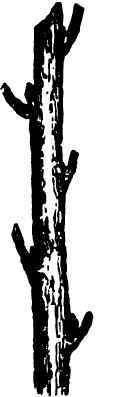
Fig. l.
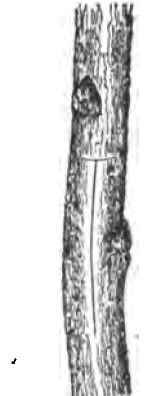
Fig. 2.
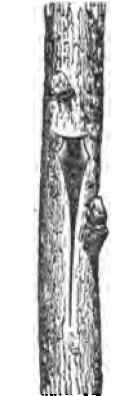
Fig. 3.

Fig. 4.
There are two conditions of plants indispensable to success in budding; first, a thrifty growth of the stalk so that the bark will slip freely; second, good, ripe buds, which may generally be known by their perfect development at the base of the leaves; and by the shield or bark to which the buds are attached, separating easily from the wood - and in short by the general firmness and ripeness of the shoots.
Plums and cherries should be budded early, whilst peaches may be set the latter part of the budding season - even into September some seasons. Apples and pears may be set from the beginning of the budding season - if the buds are ripe - until the last of August, though the early part- of the month is the best time. However, the time for commencing operations, in the budding line, varies considerably, according to the season. It answers as well to begin the 15th or the 20th of July, in some seasons and localities, as the first of August in others.
Before commencing operations, have your bud sticks in readiness, and a thin, keen edged knife, with a supply of material for tying up the buds. For this purpose, the inner bark of basswood or elm are perhaps the best material for bands; corn husks, cotton wicking and woolen yarn are also used with success.
Having selected a smooth place on the stock upon which the bud is to be inserted, preferring the north or east side, make a perpendicular incision through the bark an inch or more in length, and at the top of this a cross cut, as in fig. 2. Then ■ with the point of the knife, or with its half, if you have a regular ivory handled budding knife, raise or loosen the bark from the stock on each side of the incisionf being very careful not to bruise either the bark or sap wood beneath, as in fig. 3. As speedily as possible, and with a clean, smooth cut, take off a bud, as in fig. 6, from a stick of buds with a very little wood attached, fig. a; when this wood is loose it may be removed by putting the edge of the knife under, and between it and the bark, and lifting it up, taking care not to pull out the root of the bud, fig. b.
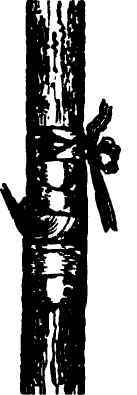
Fig. 5
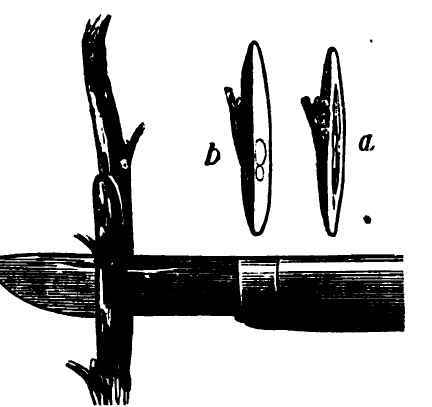
Fig. 6.
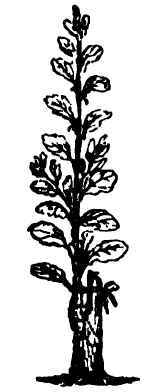
Fig. 7.
Then lift up the bark at the top of the out and insert it, which, with the aid of the foot-stalk, should be pushed down to the bottom of the incision. If the top reaches above the cross cut, cut off so as to fit exactly, fig. 4. A bandage, as in fig. 5, should be wound evenly and snugly, and tied over the whole except the bud and foot-stalk, which must be left exposed.
Care and expedition must be used in the operation to insure success, for if the parts are bruised, or suffered to become dry, they will not unite. If the foot-stalk remains fresh and green and the bud plump ten or twelve days, it indicates that the bud has taken. In two or three weeks, or as soon as the union is perfect, the bandage should be loosened, and if the stock is much swelled removed.
In budded seedlings near the ground, cut off the stock in the spring five or six inches above the bud. It is not safe to out close, as the stock will die down some distance. To secure a strong upright growth, tie the new shoot.when a few inches long to this stump, fig. 7, for the course of four Or five weeks no further support will be needed, when the stump may be wholly cut away and the wound allowed to heal, by the rapid formation of new wood.
On the whole, in cutting the bud, we rather prefer to insert the knife below instead of above and make the cut upward. An upward out gives to the bend of the bud a better point for insertion. With these very plain instructions no one of ordinary tact, need fail of becoming an expert in budding.
Continue to:


